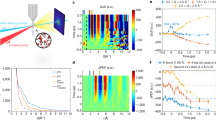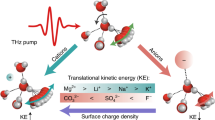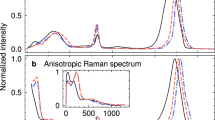Abstract
Water has many kinetic and thermodynamic properties that exhibit an anomalous dependence on temperature1,2,3,4,5, in particular in the supercooled phase. These anomalies have long been interpreted in terms of underlying structural causes, and their experimental characterization points to the existence of a singularity at a temperature of about 225 K. Further insights into the nature and origin of this singularity might be gained by completely characterizing the structural relaxation in supercooled water6. But until now, such a characterization has only been realized in simulations7,8,9 that agree with the predictions of simple mode-coupling theory10; unambiguous experimental support for this surprising conclusion is, however, not yet available11,12,13,14. Here we report time-resolved optical Kerr effect measurements15 that unambiguously demonstrate that the structural relaxation of liquid and weakly supercooled water follows the behaviour predicted by simple mode-coupling theory. Our findings thus support the interpretation7,8,9 of the singularity as a purely dynamical transition. That is, the anomalous behaviour of weakly supercooled water can be explained using a fully dynamic model and without needing to invoke a thermodynamic origin. In this regard, water behaves like many other, normal molecular liquids that are fragile glass-formers.
This is a preview of subscription content, access via your institution
Access options
Subscribe to this journal
Receive 51 print issues and online access
$199.00 per year
only $3.90 per issue
Buy this article
- Purchase on Springer Link
- Instant access to full article PDF
Prices may be subject to local taxes which are calculated during checkout




Similar content being viewed by others
References
Angell, C. A. in Water: A Comprehensive Treatise (ed. Franks, F.) Vol. 7 1–81 (Plenum, New York, 1982)
Angell, C. A. Supercooled water. Annu. Rev. Phys. Chem. 34, 593–630 (1983)
Mishima, O. & Stanley, H. E. The relationship between liquid, supercooled and glassy water. Nature 396, 329–335 (1995)
Debenedetti, P. G. Metastable Liquids Ch. 4 305–335 (Princeton Univ. Press, Princeton, 1996)
Speedy, R. J. & Angell, C. A. Isothermal compressibility of supercooled water and evidence for thermodynamic singularity at -45°C. J. Chem. Phys. 65, 851–858 (1976)
Debenedetti, P. G. & Stillinger, F. H. Supercooled liquids and the glass transition. Nature 401, 259–267 (2001)
Sciortino, F., Gallo, P., Tartaglia, P. & Chen, S.-H. Supercooled water and the kinetic glass transition. Phys. Rev. E 54, 6331–6343 (1996)
Fabbian, L. et al. Molecular mode coupling theory for supercooled liquids: Application to water. Phys. Rev. E 60, 5768–5777 (1999)
Sciortino, F. Slow dynamics in supercooled water. Chem. Phys. 258, 307–314 (2000)
Götze, W. & Sjögren, L. Relaxation processes in supercooled liquids. Rep. Prog. Phys. 55, 241–336 (1992)
Winkler, K., Lindner, J., Bürsing, H. & Vöringer, P. Ultrafast Raman-induced Kerr-effect of water: Single molecule versus collective motions. J. Chem. Phys. 113, 4674–4682 (2000)
Rønne, C., Åstrand, P.-O. & Keiding, S. R. THz spectroscopy of liquid H2O and D2O. Phys. Rev. Lett. 82, 2888–2891 (1999)
Sokolov, A. P., Hurst, J. & Quitmann, D. Dynamics of supercooled water: Mode-coupling theory approach. Phys. Rev. B 51, 12865–12868 (1995)
Bellisent-Funel, M. C., Longeville, S., Zanotti, J. M. & Chen, S.-H. Experimental observation of the α relaxation in supercooled water. Phys. Rev. Lett. 85, 3644–3647 (2000)
Righini, R. Ultrafast optical Kerr effects in liquids and solids. Science 262, 1386–1390 (1993)
Debenedetti, P. G. & Stanley, H. E. Supercooled and the glassy water. Phys. Today 56, 40–46 (2003)
Sciortino, F., La Nave, E. & Tartaglia, P. Physics of the liquid-liquid critical point. Phys. Rev. Lett. 91, 155701 (2003)
Franzese, G., Marqués, M. I. & Stanley, H. E. Intramolecular coupling as a mechanism for a liquid-liquid phase transition. Phys. Rev. E 67, 011103 (2003)
Castner, E. W., Chang, Y. J., Chu, Y. C. & Walrafen, G. E. The intermolecular dynamics of liquid water. J. Chem. Phys. 102, 653–659 (1995)
Palese, S., Schilling, L., Miller, R. J. D., Staver, P. R. & Lotshaw, W. T. Femtosecond optical Kerr-effect studies of water. J. Phys. Chem. 98, 6308–6316 (1994)
Palese, S., Mukamel, S., Miller, R. J. D. & Lotshaw, W. T. Interrogation of vibrational structure and line broadening of liquid water by Raman-induced Kerr-effect measurements within the multimode Brownian oscillator model. J. Phys. Chem. 100, 10380–10388 (1996)
Foggi, P., Bellini, M., Kien, D. P., Vercuque, I. & Righini, R. Relaxation dynamics of water and HCl aqueous solutions measured by time-resolved optical Kerr effect. J. Phys. Chem. 101, 7029–7035 (1997)
Winkler, K., Lindner, J. & Vöringer, P. Low frequency depolarized Raman-spectral density of liquid water from femtosecond optical Kerr-effect measurements: Lineshape analysis of restricted translational modes. Phys. Chem. Chem. Phys. 4, 2144–2155 (2002)
Bartolini, P., Ricci, M., Torre, R. & Righini, R. Diffusive and oscillatory dynamics of iodobenzene measured by femtosecond optical Kerr effect. J. Chem. Phys. 110, 8653–8662 (1999)
Ricci, M. A., Ruocco, G. & Sampoli, M. Raman spectra of water in the translational and librational regions. III — Temperature evolution by computer simulation with the TIP4P potential. Mol. Phys. 67, 19–31 (1989)
Torre, R., Bartolini, P. & Pick, R. M. Time-resolved optical Kerr effect in a fragile glass-forming liquid, salol. Phys. Rev. E 57, 1912–1920 (1998)
Torre, R., Bartolini, P., Ricci, M. & Pick, R. M. Time-resolved optical Kerr effect in a fragile glass-forming liquid: Test of different mode coupling theory aspects. Europhys. Lett. 52, 324–329 (2000)
Poole, P. H., Sciortino, F., Essmann, U. & Stanley, H. E. Phase behaviour of metastable water. Nature 360, 324–328 (1992)
Sastry, S. & Angell, C. A. Liquid-liquid phase transition in supercooled silicon. Nature Mater. 2, 739–743 (2003)
Acknowledgements
This work was supported by INFM, by the FIRB and COFIN programmes of Italian MIUR, and by an EC grant. We thank F. Sciortino, C. A. Angell and G. Ruocco for discussions.
Author information
Authors and Affiliations
Corresponding author
Ethics declarations
Competing interests
The authors declare that they have no competing financial interests.
Rights and permissions
About this article
Cite this article
Torre, R., Bartolini, P. & Righini, R. Structural relaxation in supercooled water by time-resolved spectroscopy. Nature 428, 296–299 (2004). https://doi.org/10.1038/nature02409
Received:
Accepted:
Issue Date:
DOI: https://doi.org/10.1038/nature02409
This article is cited by
-
Quadrupolar 23Na+ NMR relaxation as a probe of subpicosecond collective dynamics in aqueous electrolyte solutions
Nature Communications (2023)
-
Evidence of a liquid–liquid phase transition in H\(_2\)O and D\(_2\)O from path-integral molecular dynamics simulations
Scientific Reports (2022)
-
Femtosecond pulses from a mid-infrared quantum cascade laser
Nature Photonics (2021)
-
On the existence of soliton-like collective modes in liquid water at the viscoelastic crossover
Scientific Reports (2021)
-
Ultrafast hydrogen bond dynamics of liquid water revealed by terahertz-induced transient birefringence
Light: Science & Applications (2020)
Comments
By submitting a comment you agree to abide by our Terms and Community Guidelines. If you find something abusive or that does not comply with our terms or guidelines please flag it as inappropriate.



